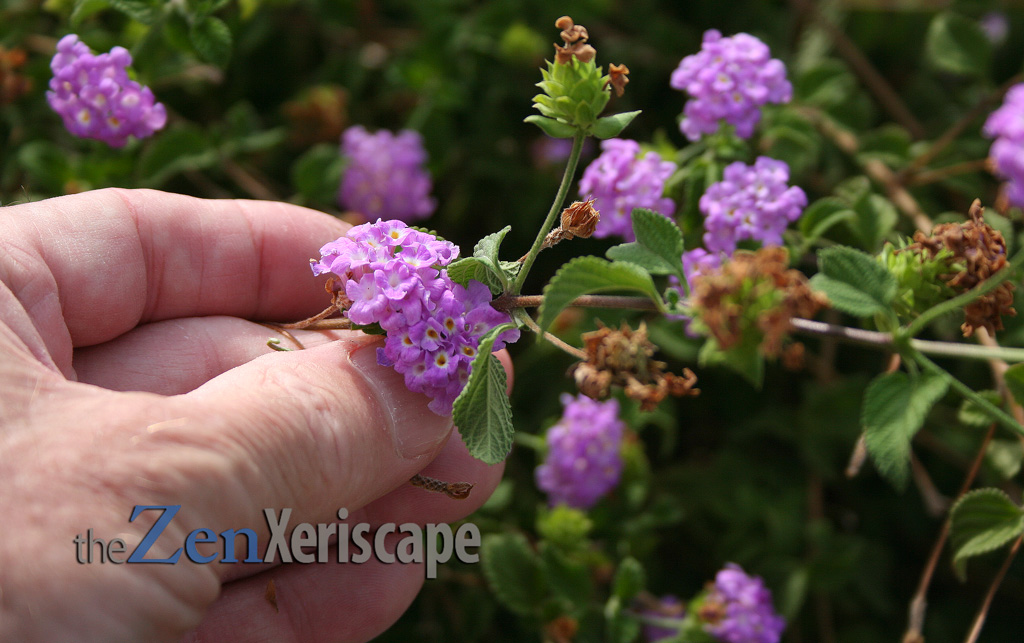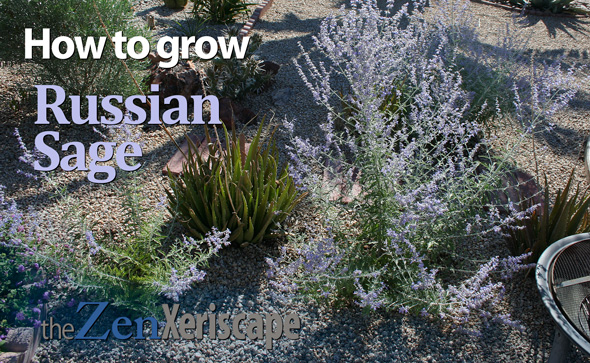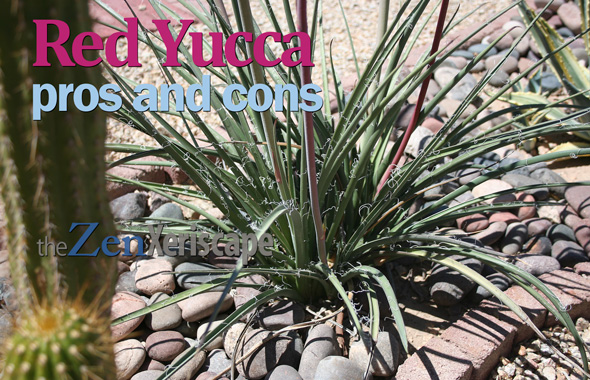I think the trailing lantana (Lantana montevidensis) looks great in my drought-tolerant, southwestern landscape. The purple-blue flowers contrast nicely with other taller plants, and the plant is able to survive extremely hot summer temps! Here are my trailing lantana pros and cons—check them out before you buy!

of vibrant purple and white flowers
throughout multiple seasons.
Photo by Doug Martin
My experiences with trailing lantana…
This is one out of the many lantana varieties that perform the best for me in my Phoenix, Arizona, arid-style landscape. It can take the brutal summer heat, and can do it without using too much water.
In the past, I have subdivided my one large clump into four smaller ones, and have used those throughout my xeriscape. It’s a wonderfully easy plant to subdivide and propagate, and then enjoy the flower show throughout the seasons.
In order to subdivide, I simply cut the lantana clumps up just like I used to do with my hostas in Pennsylvania. And while the hostas had uniquely colorful foliage, trailing lantanas have stunningly vibrant, purple flowers that add pops of season-long color in any landscape.
So now that you know I love the trailing lantana, there might be other aspects to consider before you introduce it into your drought-tolerant landscape. Here are the trailing lantana pros and cons.
Buy garden tools on clearance! (As an Amazon Associate, I earn a commission from qualifying purchases.)
Trailing lantana pros and cons
PROS
Purple flowers for never-ending beauty:
The purple-blue flowers of the trailing lantana strongly bloom throughout spring, summer, and fall here in southern Arizona. Even in December and January, it pushes out some blooms.
But, if you live in a cooler climate, you might expect to see less blooms during the colder months.
The flowers attract wildlife:
This plant’s vibrant flowers attract the bees, the birds, and the butterflies. I love all the pollinators’ activity around this plant. They add additional bursts of color and movement into the landscape.

flowers and wasn’t very worried about me.
Photo by Doug Martin
Tolerates the heat and is drought-tolerant:
The trailing lantana will thrive outside in USDA hardiness zones of 8-to-11. They can survive winter temperatures that dip down to 10-to-15 degrees F. If the vegetation does die back to the roots in those hardiness zones, it should regrow quickly in the spring.
During the intensely hot summer of 2024, my trailing lantanas survived while my arid-friendly agaves struggled. So it can flourish in 120+ degree F temperatures.
And, it’s drought-tolerant. I only water my trailing lantanas deeply once-a-week. My guess is that they could survive on even less water, but more water spurs more growth and more flowers.
Use in containers, for ground-covers, or borders:
Because it spreads out nicely from its main clump of roots, the trailing lantana’s foliage and flowers can spill-over beautifully from its containers. Place the container on a wall, and create a mass of color that complements the textures and colors of any wall.
Or, use this plant in a rock garden. It will quickly fill in empty spaces with its vibrant greens and blues, and its roots will prevent erosion.
Maintenance requirements are low:
I have only occasionally fertilized my trailing lantanas, and that was very lightly. They can probably thrive without any fertilizer. And, I only water deeply once-per-week.
During the weeks of early spring, I prune off most of the foliage from last year. Then, as the days get longer and the temperatures warm up, the pruned trailing lantana regrows quickly.
Rabbit resistant:
Well, maybe it’s rabbit resistant, or maybe not! I only grow my trailing lantanas in my walled-in landscape in the back of my house. But, I suspect that, even though the lantana foliage should be a deterrent to nibblers, that the rabbits in my neighborhood are so desperate that they would quickly chew down any trailing lantana plant.
So, while it should be “rabbit resistant”, my real-life experience says that it is probably not completely resistant to damage from rabbits or deer.
If your trailing lantanas are rabbit- and deer-resistant, please let us know in the comments below!
Can be grown in coastal locations:
The trailing lantana is salt-tolerant and can withstand salt-spray that is prevalent in coastal areas in the western and eastern United States. So, it can be grown in coastal locations within its hardiness zones!

but look beautiful all by themselves, too.
Photo by Doug Martin
Trailing Lantana pros and cons
CONS
Produces less flowers in the shade:
To get the best blooms throughout your growing season, it’s best to plant the trailing lantana in full-sun. The shade might work for this plant, but then the vegetation will get leggy and look sparse as it stretches toward the sun.
Can be invasive in some regions:
In Florida, the trailing lantana has “been categorized as an invasive plant…” (University of Florida, Purple Trailing Lantana). For that reason, the use of this plant is discouraged in Florida. That’s probably true of other zones that also receive more abundant rain and are warm throughout the year.
In my case, I have never had a trailing lantana re-seed itself in another location, other than right around the main plant. So, I think in the more arid southwestern United States, it might be considered less invasive.
Toxic leaves and sap:
The sap in the stems and leaves can irritate the skin, and might cause pets and other animals to become ill.
However, I have had dogs that were never enticed to get close to my trailing lantanas, so it was never an issue with them. And whenever I prune off the old vegetation in the spring (it can still be green), I never had an issue with a rash or other skin irritations.
Of course, I wash shortly after working in the landscape, so maybe that helps. Or, maybe I just wasn’t as sensitive to the toxicity, while other people might be more sensitive. So, use caution when handling this plant.
Insect pests:
I have never had an issue with insect pests on my trailing lantanas. However, I do see small insects in the vicinity, at least occasionally. Some of those insects might be white flies or spider mites. But, in general, I consider this plant to be pest-free!

break to rehydrate next to a trailing lantana.
The parents would chew off the leaves, while their
chicks would wander through the plant,
possibly to capture small insects for protein.
Photo by Doug Martin
Get Prime! (As an Amazon Associate, I earn a commission from qualifying purchases.)

is poking its beautiful cluster
of flowers through the trailing lantana.
Photo by Doug Martin
Takeaways:
Trailing lantana pros and cons:
This is one of the easiest to grow drought-tolerant plants in my landscape. In addition, it easily produces the most abundant display of flowers throughout the year. I don’t think any other plant can beat it in the flower-producing department!
Sure, it does have its detriments, but they have never been an issue in my xeriscape. So, for me, the trailing lantana is a winner, and should be considered for all arid landscapes, especially if you live in very hot environments.
Content and photos by Doug Martin and The Zen Xeriscape



